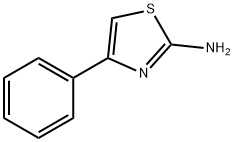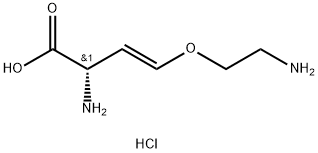A0704112
2-Amino-4-phenylthiazole , 98% , 2010-06-2
CAS NO.:2010-06-2
Empirical Formula: C9H8N2S
Molecular Weight: 176.24
MDL number: MFCD00039680
EINECS: 217-926-8
| Pack Size | Price | Stock | Quantity |
| 1G | RMB77.60 | In Stock |
|
| 5G | RMB783.20 | In Stock |
|
| 25g | RMB1519.20 | In Stock |
|
| others | Enquire |
Update time: 2022-07-08
PRODUCT Properties
| Melting point: | 149-153 °C (lit.) |
| Boiling point: | 363.4±11.0 °C(Predicted) |
| Density | 1.261±0.06 g/cm3(Predicted) |
| storage temp. | under inert gas (nitrogen or Argon) at 2–8 °C |
| solubility | DMF: 10 mg/ml; DMSO: 10 mg/ml; Ethanol: 12 mg/ml; Ethanol:PBS (pH 7.2) (1:10): 0.1 mg/ml |
| pka | 4.33±0.10(Predicted) |
| form | Crystalline Solid |
| color | White to yellow to pale orange |
| λmax | 284nm(EtOH)(lit.) |
| BRN | 128609 |
| InChIKey | PYSJLPAOBIGQPK-UHFFFAOYSA-N |
| CAS DataBase Reference | 2010-06-2(CAS DataBase Reference) |
| NIST Chemistry Reference | 2-Thiazolamine, 4-phenyl-(2010-06-2) |
Description and Uses
2-
4-Phenyl-2-thiazolamine was used to prepare suberoylanilide hydroxamic acid (SAHA) analogs with cancer cell growth inhibitory activities. It was also used to synthesize ketone histone deacetylase inhibitors with antitumor activity in vivo.
Safety
| Symbol(GHS) |    GHS05,GHS06,GHS07 |
| Signal word | Danger |
| Hazard statements | H319-H301-H315-H318-H335 |
| Precautionary statements | P301+P310a-P321-P501a-P264-P270-P301+P310+P330-P302+P352+P332+P313+P362+P364-P305+P351+P338+P337+P313-P405-P501-P261-P280-P301+P310-P305+P351+P338 |
| Hazard Codes | Xn,Xi,T |
| Risk Statements | 22-37/38-41-25 |
| Safety Statements | 26-36/37/39-45 |
| RIDADR | UN 2811 6.1 / PGIII |
| WGK Germany | 3 |
| RTECS | XJ2878000 |
| HazardClass | 6.1 |
| HazardClass | IRRITANT |
| PackingGroup | III |
| HS Code | 29341000 |
| Toxicity | mouse,LD50,intravenous,320mg/kg (320mg/kg),U.S. Army Armament Research & Development Command, Chemical Systems Laboratory, NIOSH Exchange Chemicals. Vol. NX#00815, |




